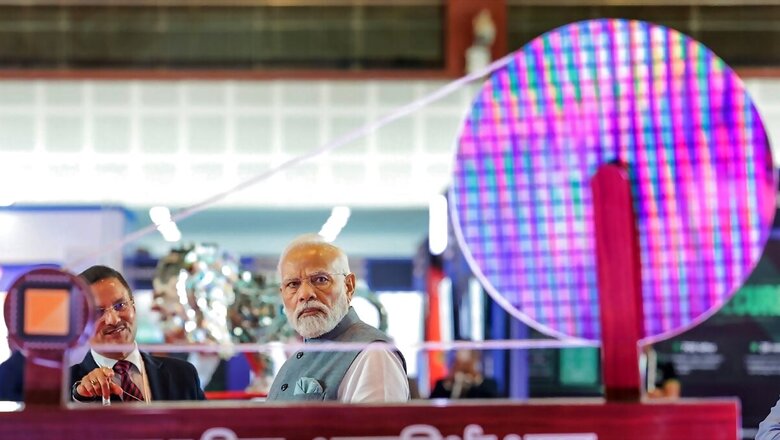
views
Assam has bolstered its standing by securing a substantial investment for a semiconductor plant, placing it alongside industrial behemoths like Gujarat and Maharashtra. In a major development on Friday (March 1), Prime Minister Narendra Modi said India will become a global centre for semiconductor manufacturing following the cabinet nod on February 29 to establish three semiconductor units.
These units will be located in Dholera and Sanand in Gujarat, and notably in Assam’s Morigaon. Construction for all three units is set to begin in the next 100 days.
The plan for a semiconductor unit in Assam stands out. Assam and the northeast have never been synonymous with technological advancement or manufacturing. Much of the talent from this region tends to seek opportunities outside the state.
But, with its first semiconductor unit – backed by the largest-ever private investment of Rs 27,000 crore – the northeast has been presented with an opportunity to overcome barriers and showcase its capabilities. It is being said Assam chief minister Himanta Biswa Sarma made an extensive push to win this massive strategic investment.
To be set up by Tata Semiconductor Assembly and Test Pvt Ltd (TSAT), this unit will be the biggest private investment in Assam so far. With this development, the state will cater to the world’s advanced semiconductor needs, including for Elon Musk’s Tesla.
Not only will the plant promote self-reliance in a strategically crucial sector, but it will also enhance Assam’s reputation as a technological manufacturing base with significant potential in electronics.
Often viewed as an unstable region and geographically distant from New Delhi, the northeast has been neglected in terms of the emergence of strategic industries. The current leadership in Delhi, supported by Sarma’s leadership, aims to change that.
A dream come true for Assam
The two semiconductor units announced for Gujarat do not come as a surprise; after all, Gujarat is a leading industrial state with all the markings of a successful bet for industry giants, and Micron is already building a semiconductor plant there.
However, for Assam, which has come out of nowhere to bag a crucial investment in chip-building, this is nothing less than a dream come true. The facility will create direct employment opportunities for at least 15,000 people and generate indirect employment for an estimated 11,000 to 16,000.
Not only this, but the placement of such a strategically crucial plant in Assam sends a message to other industry giants in the realm of manufacturing that the state indeed means business. It is a cue for more big-ticket investments to land in Assam.
Until recently, Assam had never been seen as a favourable investment destination by private players for a number of reasons. The state has a history of militancy, prolonged agitations and is far-flung from the power centres of Delhi or Maharashtra. Poor connectivity and infrastructure had further plagued the state for decades.
All this left Assam with an undesired reputation in business. For job seekers, the options have remained limited, with the public sector being their sole available avenue. In the last decade, however, Assam has witnessed a sea change in terms of connectivity and infrastructure development. It has become the gateway to the northeast.
Since 2016, it has become a bustling hub of economic activity. With the state’s GDP growing at around 15 percent, Assam’s economic renaissance is spilling over to neighbouring states. It is wise to bet on its growth story.
Assam’s economic renaissance
The guarantee of all-round stability from the Himanta-led government, bolstered by the Centre’s dedicated efforts to revamp the state’s infrastructure, has ushered a new dawn in Assam. The state forms a core part of the central government’s strategy to transform the northeast from a militancy-ridden to a strategically leveraged, prosperous region.
Investments of Rs 3.37 lakh crore have been injected between 2014-15 and 2021-22, revolutionising the region’s infrastructure. Formerly narrow pathways have transformed into expansive roads, highways and expressways. Rail infrastructure has expanded, airports have sprouted up, and waterways have been established including bridges spanning the formidable Brahmaputra river.
The Bogibheel bridge, India’s longest railroad bridge, is just one of the numerous monumental infrastructure projects that have come to fruition in the last decade. Additionally, the government is actively developing national waterways like NW-2 on the Brahmaputra and NW-16 on the Barak.
A significant accomplishment has been the resolution of numerous longstanding border disputes, although a few challenges persist. With Bodoland issues subsiding, there has been a noticeable upswing in economic activity. Remarkably, Assam has even garnered Rs 1,500 crore in oil revenue from areas that were previously troubled, such as Tinsukia and Jorhat.
Assam has been quietly adopting business-friendly policies. The state’s pioneering initiatives such as the Ease of Doing Business Bill 2016, online registration, and clearances facilitated by a single window clearance system, along with the early adoption of the GST bill, have simplified the establishment of industries.
The state began attracting private investment only in the last decade, with FMCG giants such as Hindustan Unilever and Emami leading the way by establishing manufacturing units in the state. Additionally, some pharmaceutical companies also established operations. However, none of these investments come close to the scale of the semiconductor project.
Moreover, Assam comes in with significant economic potential that is finally getting its due recognition. The state contributes 14 percent of total crude oil and 10 percent of total natural gas production in the country. It is also the largest producer of tea in India.
Its geographical location,which has long been perceived as a drag on its fortunes, is also a major strength waiting to be harnessed. Not only is it a major link between all other northeastern states, but also favourably positioned for the ‘Act East’ policy owing to its proximity with India’s eastern neighbours such as Bhutan, Bangladesh, Myanmar, Nepal, Thailand. This offers tremendous opportunities for the entire region.
A semiconductor push for posterity
India is ambitiously building a leading semiconductor industry from scratch. In the aftermath of a major semiconductor crunch triggered by chip wars between the US and China in recent years, India realised the urgency of the matter and answered its calling with a dedicated push to indigenously build this strategically crucial industry.
The Centre earmarked $10 billion under a production-linked incentive scheme, and Prime Minister Modi has pushed for major developments in this realm inviting industry leaders globally to invest in India. While India is already well-placed in the realm of chip design, its role in chip fabrication has remained negligible. The aim is to propel India’s abysmal semiconductor manufacturing scene into a high growth orbit, achieving in the next 10 years what China did in three decades. Those efforts are already bearing fruit.
In a short period of time, four major successes have been registered in this aspect. Apart from the three plants announced recently, Micron – an Idaho-headquartered semiconductor giant – is already building a plant in Sanand with a total investment of $2.75 billion. Owing to these milestones, India expects its chip-making industry to be worth $63 billion by 2026.


















Comments
0 comment